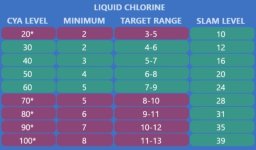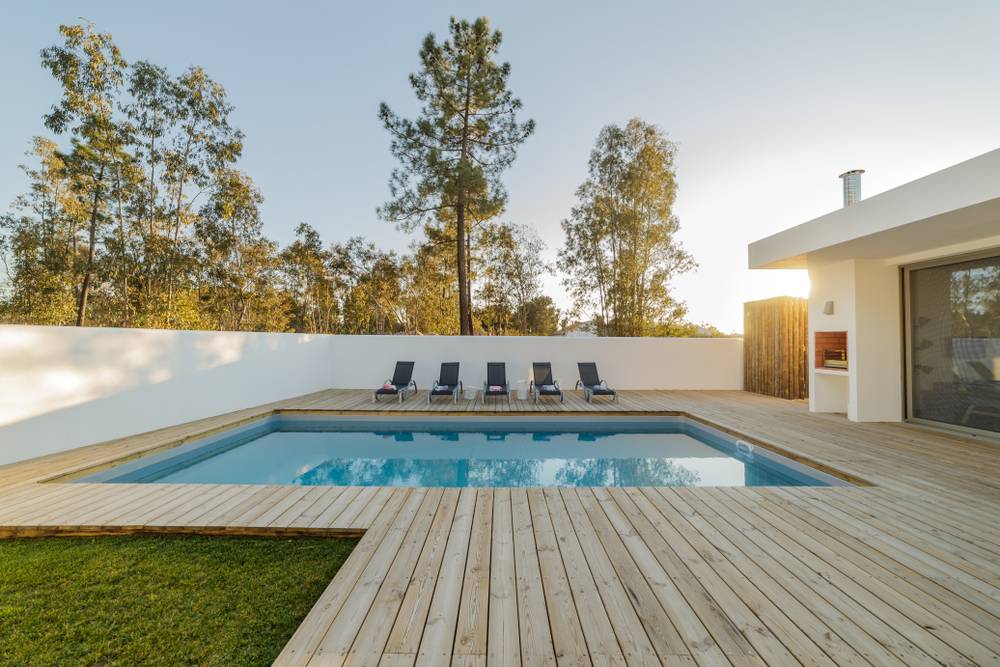I'm running a 15k gallon pool (Radiant Metric semi-inground) with solar cover and heat pump heater, with a Frog Leap system, and having one heck of a time with ever-increasing cyanuric acid levels. It's to the point where I just ran the Frog Leap without a chlorine "torpedo" most of last season, finding it easier to manually dose liquid chlorine. Unfortunately, it appears there's no chlorine pack for this sanitizer, which does not contain cyanuric acid.
We changed out about 25% of the water in the pool this spring, and have been holding the chlorine at a nice 0.5 - 2.0 ppm, which is ideal for the Frog mineral pac systems. However, our CYA levels have already crept up beyond 50 ppm, to where the dealer is now telling me I should be pushing the chlorine higher, to keep the proper free chlorine / CYA ratio. Of course, that's a slippery slope, as turning up the chlorinator also means increasing CYA input to the pool, on the Frog system.
I suspect "get rid of that Frog system" is going to be somewhere in the answers to this post, but my dealer seems to love them, and I do like the idea of running lower chlorine levels they promote. I just don't understand why they put so much CYA in these things, and don't offer a low-CYA or even CYA-free version of the torpedo packs, for those of us having this problem. It appears I'm not the only one.
Two questions to start:
1. I'm told the only way to lower CYA is by water exchange, but I also see products online that claim to reduce or remove CYA. Do they work? How?
2. Would removing the solar cover reduce CYA? I've seen conflicting info on this. I thought solar cover (blue) = reduced need for chlorine = reduced CYA input from sanitizer, since the CYA is in the chlorine tablets.
The only other complicating factor is that the sanitizer is downstream of our heater, which runs variably according to weather, and whether we have the solar cover installed overnight. When the heater runs a lot, the chlorine (with CYA) levels spike up, due to heated water dissolving the tablets much more quickly than unheated water. The Frog will over-chlorinate the pool in this scenario, even with it's control knob dialed down to zero, unless you remove the chlorine torpedo or bypass the Frog completely.
Thanks!
We changed out about 25% of the water in the pool this spring, and have been holding the chlorine at a nice 0.5 - 2.0 ppm, which is ideal for the Frog mineral pac systems. However, our CYA levels have already crept up beyond 50 ppm, to where the dealer is now telling me I should be pushing the chlorine higher, to keep the proper free chlorine / CYA ratio. Of course, that's a slippery slope, as turning up the chlorinator also means increasing CYA input to the pool, on the Frog system.
I suspect "get rid of that Frog system" is going to be somewhere in the answers to this post, but my dealer seems to love them, and I do like the idea of running lower chlorine levels they promote. I just don't understand why they put so much CYA in these things, and don't offer a low-CYA or even CYA-free version of the torpedo packs, for those of us having this problem. It appears I'm not the only one.
Two questions to start:
1. I'm told the only way to lower CYA is by water exchange, but I also see products online that claim to reduce or remove CYA. Do they work? How?
2. Would removing the solar cover reduce CYA? I've seen conflicting info on this. I thought solar cover (blue) = reduced need for chlorine = reduced CYA input from sanitizer, since the CYA is in the chlorine tablets.
The only other complicating factor is that the sanitizer is downstream of our heater, which runs variably according to weather, and whether we have the solar cover installed overnight. When the heater runs a lot, the chlorine (with CYA) levels spike up, due to heated water dissolving the tablets much more quickly than unheated water. The Frog will over-chlorinate the pool in this scenario, even with it's control knob dialed down to zero, unless you remove the chlorine torpedo or bypass the Frog completely.
Thanks!



